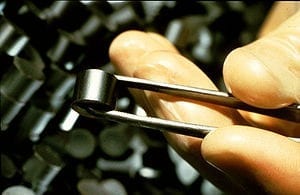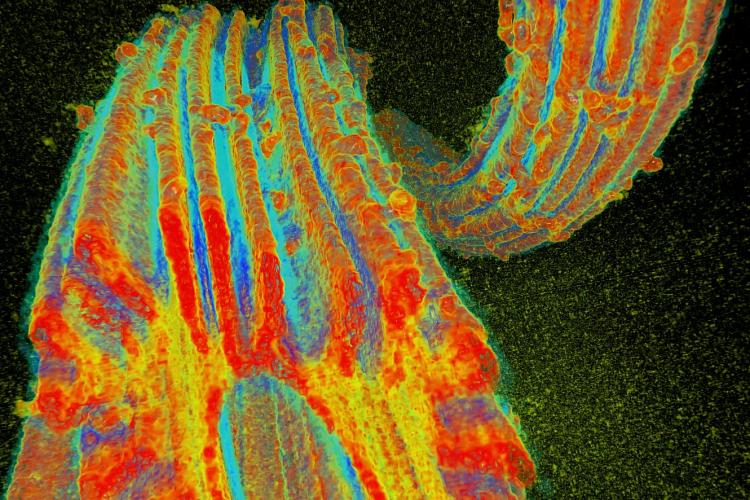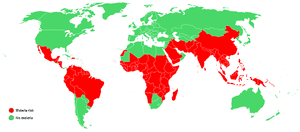
Since we face outsized problems from burning fossil fuels, an atomic-sized solution, with few emissions and well understood risks, can seem attractive
A believer in solar power rarely has a good word to say about nuclear, though the sun generates light in a nuclear way via fusion. Of course, the zealotry works in the other direction as well. Almost any energy source boasts a cadre of ardent adherents: burning coal (it alleviates poverty!). Fracking for natural gas (we’re better than coal!) Wind turbines(the fuel is always free!) Even fusion here on Earth. If you don’t believe me,check the comments on this piece.
So it’s no surprise that energy has proven a wedge issue among those who strive to save the world. Now along comes a new, intriguing documentary entitled Pandora’s Promise that hits movie theaters on June 12 and promises to drive that wedge even deeper.
The story of the film is your basic conversion narrative, minus the conversion onscreen and geared to produce a hoped-for one in the audience. A band of five self-professed converts to the benefits of nuclear power—iconoclast Stewart Brand, author Gwyneth Cravens, climate activist Mark Lynas, nuclear weapons expert Richard Rhodes, and environmental thinker Michael Shellenberger—lay out their individual reasons for their newfound belief.
That newfound belief runs counter to that of the majority of environmentalists and environmental organizations from the beginnings of the movement in the 1970s. Much of that opposition stems from the original sin of nuclear power: it was used as a weapon first. Nuclear became synonymous with mushroom clouds at Hiroshima and Nagasaki and many other testing grounds and skies, mutually assured destruction, even nuclear winter and some kind of Armageddon, in the words of Whole Earth Catalog founder Brand.
What has cracked that catholic opposition for Brand and others is the invisible and invidious challenge of climate change. Simply put: nuclear power is one of the few technologies available today that can produce a lot of electricity, a lot of the time without a lot of greenhouse gases entering the atmosphere. To be anti-nuclear at this point means being for burning fossil fuels because energy sources such as solar and wind are too fickle and small to play a big role in providing clean electricity to the 7 billion people on the planet, according to this belief.
The film, through interviews with engineers and others, also notes that another original sin of nuclear power may have been the technology chosen by U.S. Admiral Hyman Rickover in the 1950s. The light water reactors the “Father of the Nuclear Navy” selected for commercial development may be simpler in design but they produce nuclear waste fairly rapidly and in quantity that still has no place to go. Safety is not an inherent feature of such reactors but instead has to be engineered around them with the cloak of containment vessels, redundant systems and other support and safety systems that add to the expense of nuclear power today. In fact, light water reactors are one of the few technologies to see little or no reduction in cost as more and more of them were built over the past several decades. Each one was, in essence, custom-designed to deal with the specific issues for a particular site and the specific version of the technology deployed.
That has left each reactor with its own unique flaws, as witnessed in the three nuclear catastrophes in Three Mile Island, Pennsylvania; Chernobyl, Ukraine; and Fukushima, Japan. Each reactor may be flawed in its own way, but the three milestone accidents did share one critical failing in common: the human factor. In all three, human oversight, omission, and/or flat-our error played a pivotal role in allowing the nuclear accidents to occur—so much so that engineers of new reactor systems have emphasized the removal of humans from their oversight in an accident entirely. So-called passive safety designs—such as the two new AP-1000 reactors being built at the Vogtle nuclear power plant in Georgia—require no human intervention to work. These systems intend to provide some insurance against human error leading to catastrophic meltdown.
And the world needs more and more power. Lifting hundreds of millions of Chinese people out of poverty in the last few decades required the construction of hundreds ofcoal-fired power plants, which has lead to China disappearing beneath a sulfurous haze of choking smog as well as surpassing the U.S. as the world leader in greenhouse gas pollution. Energy efficiency can’t save us from that, according to the Breakthrough Institute’s Shellenberger. As the global population heads toward 9 billion or even more potentially, energy use may double by 2050 and continue to increase. To stop adding yet more greenhouse gases to the atmosphere, all of that energy would have to be clean energy. And the only clean energy available is nuclear, according to Shellenberger and the other true believers of this film—in the absence of CO2 capture and storage for fossil fuel burners or some form of inexpensive electricity storage in the case of renewables like the wind and sun.
Size is an enduring totem for the proponents of nuclear power: the poster for the film above shows the actual size of the tiny cube of enriched uranium that could provide enough electricity for your entire life. And the filmmaker’s own conversion experience came when he visited the single room in France, the size of a basketball court, beneath which much of that nation’s nuclear waste is stored. Here is another size comparison: a pound of uranium contains as much energy as more than 2 million pounds of coal. Size matters and, since we face outsized problems from burning fossil fuels, an atomic-sized solution, with few emissions and well understood risks, can seem attractive.
That means we have to get over our overblown fears of radiation.
The Latest Bing News on:
Nuclear Power
- Nuclear Fusion Breakthroughs Bring Near-Limitless Energy Closeron April 30, 2024 at 5:45 am
Physicists say the discovery offers a potential avenue to "economically attractive fusion energy" in the future.
- CEZ gets French, S.Korean bids to build up to four nuclear power unitson April 30, 2024 at 5:31 am
Czech majority state-owned utility CEZ has received updated binding bids from South Korea's KHNP and France's EDF in a tender to build up to four nuclear power units, the company said on Tuesday.
- After Vogtle, what’s next for nuclear?on April 30, 2024 at 3:53 am
The Georgia reactors came online Monday — seven years late at a cost of $35 billion, more than double the initial $14 billion estimate.
- A.M. ATL: Nuclear power and your pocketbookon April 30, 2024 at 2:47 am
Today’s newsletter has the latest on Israel-Hamas war protests on Georgia college campuses, Vice President Kamala Harris’ visit to Atlanta and Matt Ryan’s new TV gig. Plus the AJC’s hip-hop doc at the ...
- EU approves Czech state aid for nuclear power plant constructionon April 30, 2024 at 1:47 am
The European Commission said on Tuesday it had approved state aid offered by the Czech Republic for the construction of a nuclear power plant.
- Nuclear power back in global spotlight at 26th World Energy Congresson April 30, 2024 at 1:18 am
Mr Grossi and the IAEA took part in several events showcasing the benefits of nuclear power, which in recent months has surged to the top of the global climate and energy agenda.
- Ninth Circuit clears way for Diablo Canyon nuclear power plant license extensionon April 29, 2024 at 3:42 pm
(CN) — The Diablo Canyon nuclear power plant's new lease on life cleared another hurdle on Monday when the Ninth Circuit Court of Appeals denied a challenge to a license extension granted by the ...
- Trump Or Biden, Nuclear Power Is Crucial For The Energy Transitionon April 29, 2024 at 9:54 am
As the world grapples with the existential threat of climate change, one energy solution transcends partisan politics: a bold reinvestment in nuclear power.
- A second new nuclear reactor is completed in Georgia. The carbon-free power comes at a high priceon April 29, 2024 at 8:50 am
The second of two new nuclear reactors in Georgia has entered commercial operation, capping a project that cost billions more and took years longer than originally projected. Georgia Power Co. and ...
- Plant Vogtle Unit 4 nuclear reactor enters commercial operation, says Georgia Poweron April 29, 2024 at 8:08 am
With all four units now in operation, Plant Vogtle is expected to produce more than 30 million megawatt hours of electricity each year.
The Latest Google Headlines on:
Nuclear Power
[google_news title=”” keyword=”Nuclear Power” num_posts=”10″ blurb_length=”0″ show_thumb=”left”]
The Latest Bing News on:
Nuclear waste
- Ancient Egyptian curse came as 'tombs were used to store radioactive nuclear waste'on April 29, 2024 at 1:17 pm
A new study has suggested that the high radiation levels found in ancient Egyptian tombs may be linked to the storage of nuclear waste.
- Palisades reopening signals shift toward restarting other nuclear plantson April 29, 2024 at 1:15 pm
While environmentalists remain opposed to nuclear plants, others see them as a way to produce big amounts of power without spewing greenhouse gases.
- $418 million for South Bruce to host nuclear waste projecton April 29, 2024 at 12:13 pm
If the Municipality of South Bruce permanently houses Canada’s used nuclear fuel, it will be paid $418 million over the next 138 years to do so.
- Trump Or Biden, Nuclear Power Is Crucial For The Energy Transitionon April 29, 2024 at 9:54 am
As the world grapples with the existential threat of climate change, one energy solution transcends partisan politics: a bold reinvestment in nuclear power.
- The ‘twisted doughnut’ reactor that could bring nuclear fusion a step closeron April 28, 2024 at 10:00 pm
Nuclear fusion may be a step closer after a radical new reactor design shaped like a twisted doughnut was unveiled by a task force set up by the King.
- Waste not, want not: How methane biogases can help us reach our climate goalson April 28, 2024 at 5:00 am
How can the U.S. meet its 30×30 methane goal? Tapping America’s massive organic waste streams as a renewable energy resource.
- Ancient Egyptian tombs might have been used to store radioactive nuclear waste as study cracks 'Pharaoh's curse'on April 27, 2024 at 6:18 am
Ancient Egyptians may have been dabbling with nuclear technology, a new study suggests, as the 'Pharaoh's curse' that killed many who walked in the tombs is linked to buried radioactive nuclear waste ...
- Why Germany ditched nuclear before coal—and why it won’t go backon April 27, 2024 at 4:27 am
In the face of climate change, calls to expedite the transition away from fossil fuels, and an energy crisis precipitated by Russia’s 2022 invasion of Ukraine, Berlin’s move to quit nuclear before ...
- $15M elevator repairs at Waste Isolation Pilot Plant nuclear repository starting in Julyon April 26, 2024 at 3:58 am
A $15 million project to rebuild part of an elevator at the Waste Isolation Pilot Plant used to move mined salt out of the underground was planned for July and expected to be completed by October, ...
- Missouri Senate advances KC weapons facility tax break without aid for nuclear waste victimson April 25, 2024 at 7:36 am
An effort to create a program for St. Louis-area residents affected by radioactive waste nearly derailed a Missouri Senate bill backed by the Kansas City delegation to help expand a facility ...
The Latest Google Headlines on:
Nuclear waste
[google_news title=”” keyword=”nuclear waste” num_posts=”10″ blurb_length=”0″ show_thumb=”left”]










